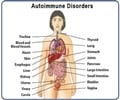4-amino pyridine drug for multiple sclerosis was found to be effective in diagnosing and treating chronic nerve damage.

The study appearing in EMBO Molecular Medicine, demonstrates for the first time that 4-aminopyridine (4AP), a drug currently used to treat patients with the chronic nerve disease, multiple sclerosis, has the unexpected property of promoting recovery from acute nerve damage. Although this drug has been studied for over 30 years for its ability to treat chronic diseases, this is the first demonstration of 4AP's benefit in treating acute nerve injury and the first time those benefits were shown to persist after treatment was stopped.
Study authors, John Elfar, M.D., associate professor of Orthopaedics, and Mark Noble, Ph.D., Martha M. Freeman, M.D., Professor in Biomedical Genetics, and their laboratory team, found that daily treatment with 4AP promotes repair of myelin, the insulating material that normally surrounds nerve fibers. When this insulation is damaged, as occurs in traumatic peripheral nerve injury, nerve cell function is impaired. These researchers found that 4AP treatment accelerates repair of myelin damage and improvement in nerve function.
These findings advance an area of research that has been stagnant for nearly 30 years and may address unmet needs of traumatically injured patients in the future. The current standard of care for traumatic peripheral nerve injury is "watchful waiting" to determine whether a nerve has the ability to spontaneously recover, or if it will require surgery.
The problem, says Elfar, a Sports Medicine surgeon specializing in hand, wrist, elbow and shoulder repairs, is that "the patient who may recover is recovering so slowly that nerve-dependent tissues are in jeopardy, and the patient who needs surgery has to wait for weeks for the diagnosis that surgery is appropriate. That delay means that surgery is less effective."
Elfar's and Noble's team, which includes Kuang-Ching Tseng, Ph.D., former graduate student in the Center for Musculoskeletal Research at the University of Rochester Medical Center and first author of the study, also found that treating mice with a single dose of 4AP one day after nerve crush injury improved muscle function within an hour. In this model, nerves are damaged, but not completely severed. The team believes this finding may suggest that 4AP could be used immediately after an injury to diagnose whether a nerve is severed, however further studies are required to determine if this will work in humans.
Advertisement
The Department of Defense has recognized the potential impact this could have for soldiers in combat situations and granted $1 million to Elfar and Noble to continue this research over the next three years.
Advertisement
Beyond nerve injuries sustained during accidents or in the line of duty, the researchers are also looking into using 4AP to repair nerve conduction after routine surgeries. Removal of the prostate, for example, can cause nerve damage that leaves patients with incontinence and erectile dysfunction, the burden and stigma of which may contribute to prostate cancer patients refusing the surgery.
Elfar and Noble hope to begin a clinical trial to test this in the near future. The proposed trial has been approved by the Food and Drug Administration (FDA), and University of Rochester researchers and clinicians are completing the planning stages before recruiting participants.
Source-Eurekalert















